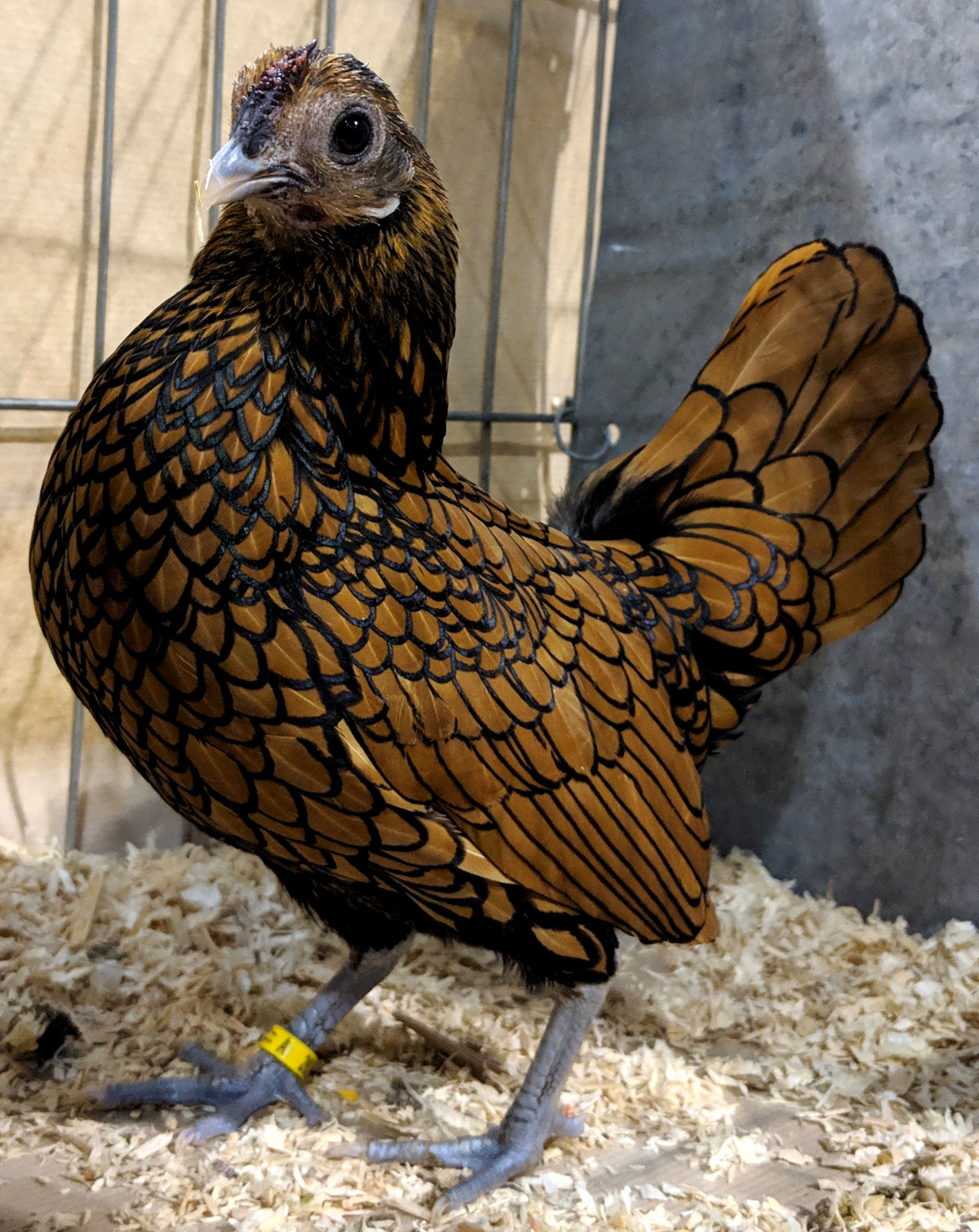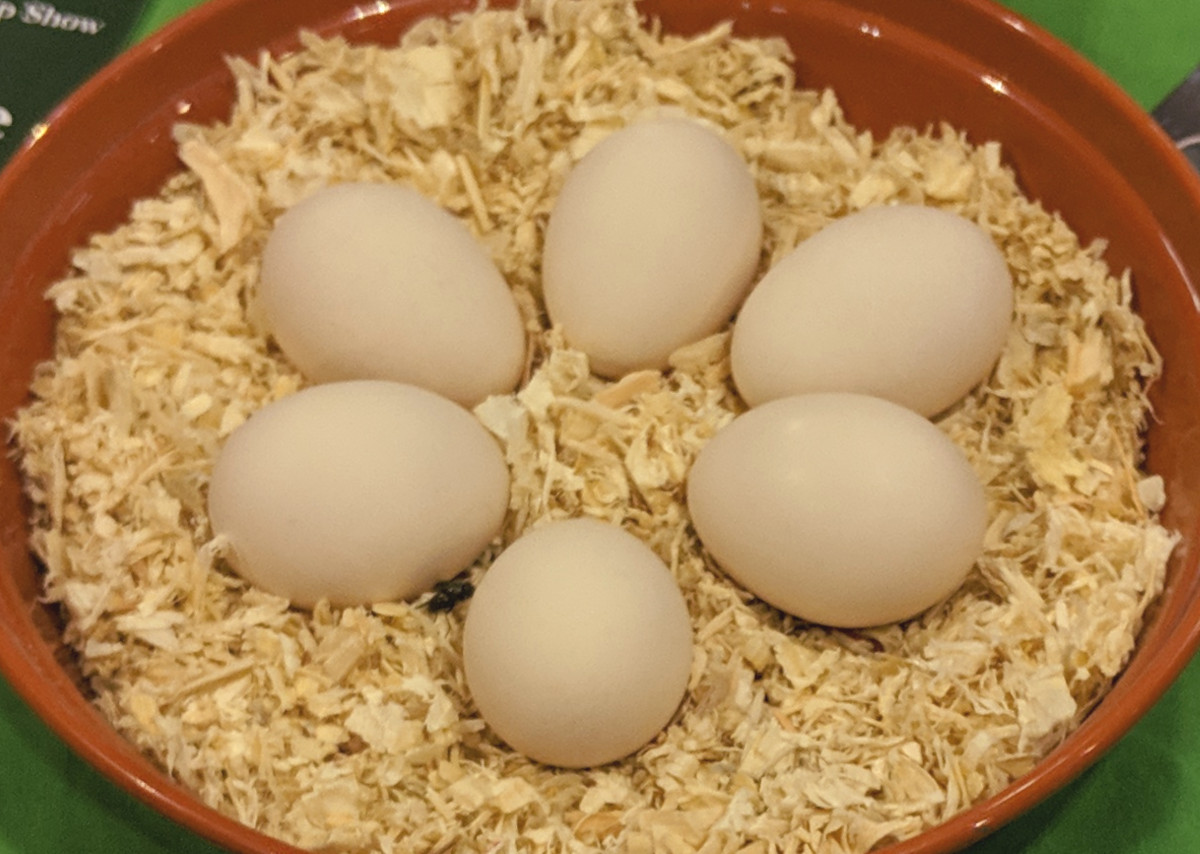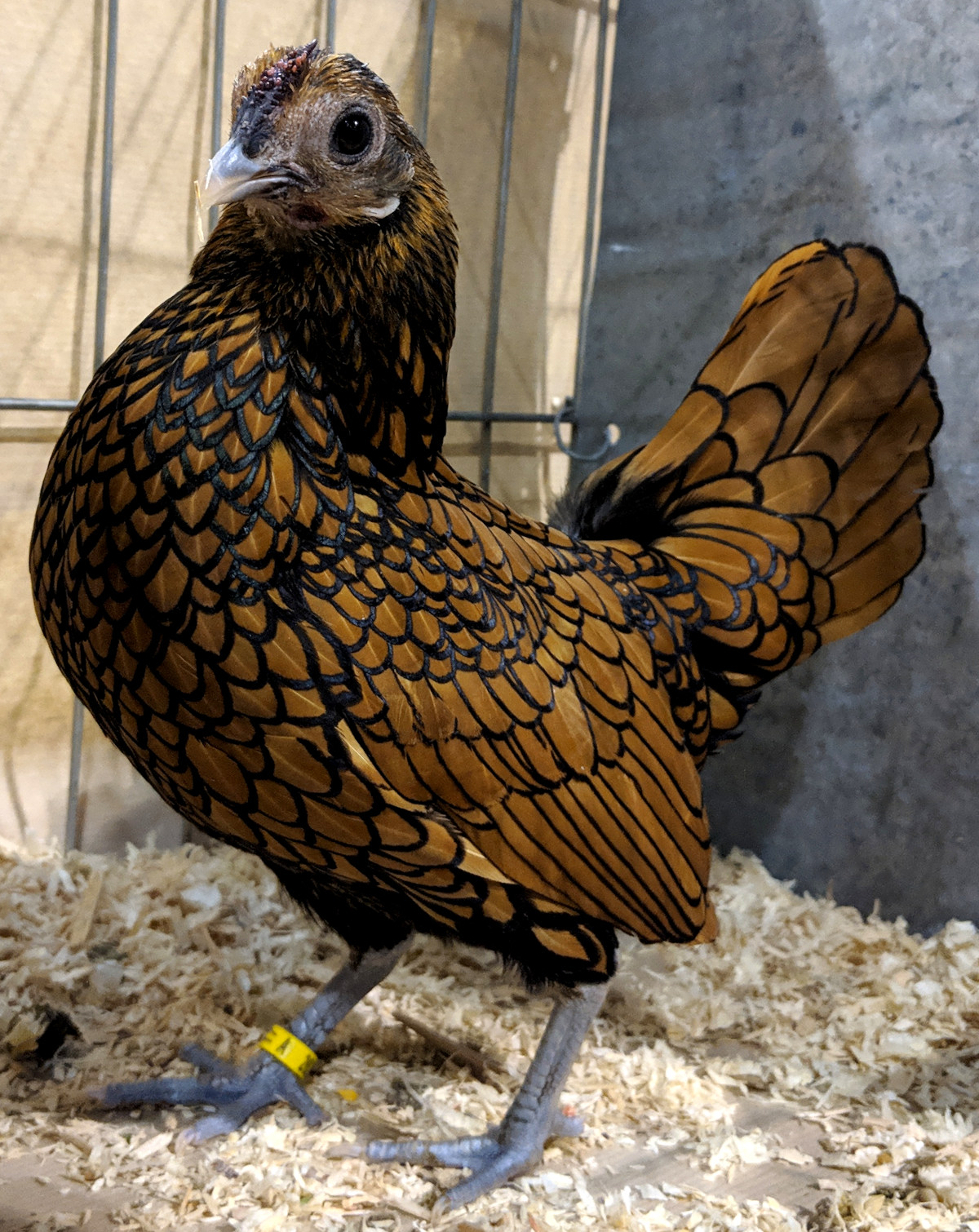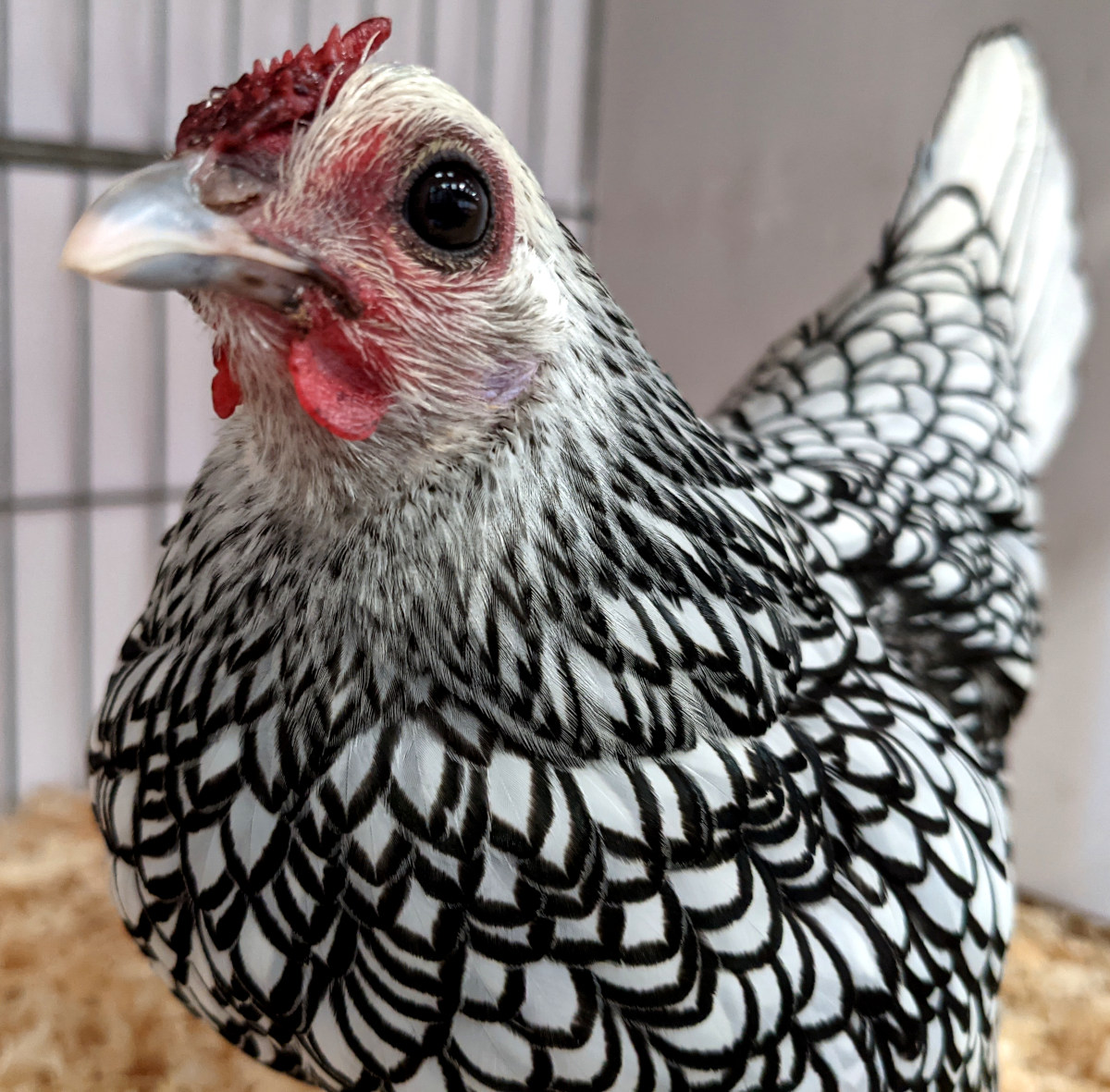Sebright bantams. A hen feathered delight with over 200 years of history.

Originating in England during the 1800s, the Sebright is a stunning Bantam chicken created by the late Sir John Sebright. These elegant birds are the result of thirty years of diligent trial and error, with an incredibly thorough knowledge of genetics, and extremely strict selective breeding.
Table of Contents
- What are Sebright chickens known for?
- Sebright eggs:
- The Sebright breed standards:
- Are Sebrights hard to raise and care for?
- Sexing Sebright chickens:
- Are Sebright chickens noisy?
- Are Sebrights friendly and do they make good pets?
- What are the problems with Sebright bantams?
- What are the different types of Sebright bantam chickens?
- Where can I buy Sebright bantam chickens?
- How much do Sebright bantam chickens cost?
- Sebright bantam history: An original bantam breed.
Sebright bantams are a small breed of chicken that is known for its beautiful plumage and docile nature. They are a popular breed for both show and pet purposes.
I have kept and shown Gold laced Sebrights for many years but my silvers are strictly pets.
What are Sebright chickens known for?
The Sebright is a true English bird, named after its developer, Sir John Saunders Sebright, a gentleman farmer and Member of Parliament for Hertfordshire.
Sebrights are, first and foremost, strictly an “Ornamental” bantam chicken. This means they are bred for looks alone, nothing more.
Below: Due to their thin build and small size as a whole, their lack of potential as a meat bird is obvious, but they are also generally poor egg layers, producing only 80 to 100 very tiny white eggs per year.

The unique characteristics of the Sebright bantam chicken:
- They are one of only 3 breeds of chicken to be “hen-feathered” meaning the hens and cockerels have the same shape feathers and pattern.
- Sebrights are one of the oldest true bantam breeds with a history dating back more than 200 years.
- They are a small breed, with males weighing in at around 22 ounces and females weighing in at around 20 ounces.
- Sebright bantams are a true bantam, meaning they have no larger equivalent.
- They have a short back, a proportionally large breast, and downward-pointing wings.
- Males carry a rose comb covered with fine points, and a leader or small spike that sweeps back from the head.
- These little chickens are excellent flyers and keeping them contained is almost impossible.
- Sebright bantam chickens have a lifespan of 5-8 years.
- Sebrights are known for their docile and friendly nature. They are a good choice for families with children, as they are patient and gentle.
- Sebrights are not renowned for being broody hens but will go broody occasionally, most likely in their second season, and make good attentive mothers to small clutches.
- These birds are active, like to free range and can be kept with other chickens.
Sebright eggs:
Sebright Bantams are not known for their egg-laying abilities, most Sebright hens will never lay more than 80 eggs per year. They are primarily kept for their ornamental qualities and lively personalities.
The eggs of Sebright bantams are both edible and delicious, I often eat my surplus ones and they have a good yolk to white ratio. The eggs of Sebright bantams are also small, Mine average just 28 grams in weight.
They are white in colour and have a smooth, glossy shell.
Below: A display of Sebright bantam eggs.

Sebright bantams are not known for being prolific egg layers, but they do lay 2 to 3 eggs per week during the season.
While the eggs are small, the feed efficiency is passable as they birds are so small and eat relatively little.
A Sebright hen will typically come into lay at around 30 weeks of age and lay about 60-80 eggs per year.
The Sebright breed standards:
Sebrights stand with a confident, upright stature. With their wings kept low, neck gracefully curved, chest perpetually puffed, and tail held high, these bantam chickens have a sleek and elegant silhouette. They have large, expressive black eyes.
The weights are 620 g or 22 oz for the males and 510 g or 18 oz for the females.
These bantam chickens are well known for their “laced” feather pattern, wherein each feather appears carefully traced with a black pen, not unlike a living pop-art portrait of a chicken!
Below: A quality example a Sebright hen.

In show-quality birds, it’s important for the lacing of the feathers to be refined and delicate, intricately edging each and every feather. It is not uncommon for hatchery stock to have messier, thicker lacing that is less uniform, sometimes even “muddy” looking.
The American Standard of Perfection describes an ideal Sebright as follows:
- The beak should be a dark, gray-brown colour described as “horn-coloured”.
- It’s desirable for the face and comb to be “Mulberry” (slightly purple), but red is acceptable.
- Earlobes should always be Mulberry in colour.
- The wattles should be bright red.
- Slate-coloured skin should cover the rest of the body, under the feathers.
- Their legs should be a muted gray-blue.
- Sleek, smooth feathers and uniform lacing throughout.
- Males should be “Hen-feathered”, a feature I will describe in further detail below.
- The only colours recognised by the Standard of Perfection are Gold and Silver.
Sebright bantams are known for their beautiful plumage. They only come in two varieties: golden and silver.
The scale of points for judging Sebrights:
Lacing 25
Comb 5
Face and lobes 10
Ground colour 15
Tail 10
Type 20
Weight 5
Condition 10
The golden Sebright has a golden-brown body with black markings, while the silver Sebright has a silver-white body with black markings. Both varieties have a lace-like pattern on their feathers.
Faults and disqualifications in the Sebright include:
- Having a pale shaft to their feathers,
- Single comb,
- Sickle feathers or pointed hackles in the male,
- Feathers on shanks,
- An uneven ground colour or light in the gold,
- Legs other than slate-blue,
- Anything other than four toes,
- Pointed or square ended feathering, the correct feather shape is almond shaped,
- Lacing that is too thick. Narrow laced feathering is preferred,
- Any deformity.
Are Sebrights hard to raise and care for?
One of the most notable characteristics of Sebrights is their lively personalities. They are active and curious birds, always on the move and exploring their surroundings. They are also known for being somewhat independent and can be challenging to train, but their playful nature makes them a joy to watch.
Below: The Sebright is inquisitive and friendly.
Like all chickens, Sebright bantams require proper care and attention to thrive. Here are some important care requirements to keep in mind:
Housing: Sebright Bantams are small and do well in a variety of housing options. Sebrights, among one of the smallest bantam breeds, take up very little coop real estate and consume much less food than the average chicken! A coop with at least 2-3 square feet per bird, along with access to a secure outdoor run, is ideal. Make sure the coop is well-ventilated and predator-proof. As Sebrights are active birds they require a coop that is large enough for them fly around comfortably, as well as a run where they can exercise.
Diet: Sebright Bantams need a balanced diet that includes a high-quality commercial feed and plenty of fresh water. They also enjoy foraging for insects and greens, so providing them with access to a chicken-friendly garden or pasture is beneficial. I have had better results feeding a diet that is a little higher in protein, and they should have access to fresh water at all times.
Other chickens and poultry: Sebright Bantams can be kept with other chicken breeds, but they may need special accommodations due to their small size and active nature. Sebrights are shy among other chickens, typically staying comfortably low in the pecking order, but they can be easily bullied by large fowl chickens and it’s advisable that they be kept separately if not free range.
Sexing Sebright chickens:
Sexing Sebright bantam chickens can be challenging, especially when they are young. I rarely bother trying to accurately sex mine until they are at least 8 weeks old.
This is made even more difficult by the fact that Sebrights are hen feathered, meaning the hens and cockerels feather up in the same way, at the same speed and have the same feather shape.
There are two foolproof and guaranteed ways to accurately sex Sebright chicks:
- Vent sexing - Using the features of the vent to sex day old chicks.
- DNA sexing - Sending a sample to a laboratory to be analysed.
There are a few methods that can help determine the sex of Sebright bantams but they all involve waiting till the secondary sexual characteristics begin to show:
Combs and wattles: Males typically have faster growing, larger and more prominent combs and wattles compared to females. This can be more apparent as they mature.
Behaviour: As they grow older, males tend to exhibit more aggressive and dominant behaviours, such as chest bumping, crowing, fighting, and attempting to mate with hens.
Body shape: Males tend to have a more upright, streamlined and muscular and the body shape is more stocky compared to females, who have a rounder and plumper body shape.
Legs: Sebright males have slightly longer and thicker legs than the hens but this doesn't become apparent until they are a little older.
Keep in mind that these methods are not foolproof, and it can be difficult to determine the sex of a Sebright bantam chicken accurately until they are fully mature.
Are Sebright chickens noisy?
For such small sized chickens Sebright roosters have a loud, high pitched, piercing sharp crow that is considered by many to be unpleasant but it doesn't bother me or I have got used to it by now.
My hens have a lot to say, too, making Sebrights a poor choice for those with sensitivity to noise or disgruntled neighbours.
I find both the hens and cockerel very chatty and I often find mine fluttering about making a noise like a rusty gate.
Are Sebrights friendly and do they make good pets?
These bantam chickens are a beautiful, gentle natured addition to most coops, and can be a quirky, comical bird to keep, but they also have their distinct ups and downs that may mean they aren’t for everyone.
Below: My Silver Sebright cockerel showing how friendly and tame he is.
I have never found my Sebrights to be shy or nervous, They are more restless than the average chicken breed. Personal space and consistent time out free-ranging is important for them, and a lack of activity may lead to anxiety, and causing aggression in Roosters.
What are the problems with Sebright bantams?
Sebright bantam chickens are generally healthy birds, but they are susceptible to some of the same health concerns as other breeds of chickens. Some of the most common health concerns include:
- Susceptibility to Marek's disease,a viral disease that can cause paralysis and death in chickens.
- They can be expensive to purchase.
- Hen feathering is said to have an adverse effect on the fertility of male Sebrights.
- They do not lay as many eggs as other breeds of chickens.
- Sebrights are not fully hardy and require more care than other breeds of chickens.
- They are good flyers and excellent escape artists.
- Their small size makes them easy prey for cats and sparrowhawks.
What are the different types of Sebright bantam chickens?
There are two recognised types or colours of Sebright bantam chickens:
- The golden or gold laced Sebright.
- The silver or silver laced Sebright.
The golden Sebright is the more common type, and it has a golden-brown body with black lacing on the feather edges.
Below: The silver Sebright is less common, and it has a silver-white body with black markings.

Lemon and Buff laced Sebright have been bred in recent years but neither have found their way into the standards yet.
Where can I buy Sebright bantam chickens?
Sebright chickens are relatively rare and difficult to find, especially quality specimens.
You can buy Sebright bantam chickens from a variety of sources, including:
- Local poultry breeders,
- Sebright club breed register,
- Online poultry hatcheries,
- Facebook and other social media groups,
- Poultry shows and auctions.
Bear in mind that hatchery stock is unlikely to be show quality.
How much do Sebright bantam chickens cost?
The cost of Sebright bantam chickens varies depending on the breeder and the quality of the birds. However, you can expect to pay anywhere from $25 to $100 per bird.
- Expect to pay $2 to $6 each for Sebright hatching eggs,
- Day old chicks will set you back $5 to $10 each,
- Off heat growers are likely to cost $15 to $25 each,
- Fully grown POL Sebrights can cost anything from £25 to $100 or even more.
Whether or not you should get a Sebright bantam chicken depends on your individual needs and preferences.
Sebright bantam history: An original bantam breed.
Sebright bantam chickens were first bred in England in the early 1800s by Sir John Sebright, the 7th Baronet of Besford, Worcestershire and a Member of Parliament for Herefordshire in the early 1800s, and is one of the oldest British bantams.
He wanted to create a breed of chicken that was both beautiful and practical, and he succeeded in doing so. Sebright bantam chickens quickly became popular, and they are still one of the most popular breeds of bantam chickens today.
Like many bantam chicken breeds, not much is known about the entire process, as Mr. Sebright kept much of it to himself, but it is widely believed that the Hamburg and a true bantam known as the Nankin played major roles in their development. Some sources cite the use of a laced Polish in the creation but Sebrights have never sported a crest like the Polish birds do.
The shape, posture and wing position points more towards the use of the Japanese bantam or chabo in the breeding of Sebrights.
Sebright history timeline:
- Sir John Sebright begins his work breeding in 1800 after acquiring a Nankin and a "cockerel destitute of of sickles and possessing hen feathered hackles" from Norwich. It is reported he bought a gold pencilled hen from Watford at the same time.
- Sir John Sebright publishes his influential work - "The art of improving the breeds of domestic animals" in 1809.
- The original Sebright Club was founded by Sir John Sebright in 1810 some years after he started work on the breeding of the bird. It was the first poultry breed to have its own specialist club for fanciers.
- Sebrights in the 1830's were more inclined to spangling than lacing suggesting that the hamburg was definitely part of their make up.
- The Sebright was admitted to the Poultry Club of Great Britain Standard and American Poultry Association Standard of Perfection in 1874.
- Harrison Weir whose work ‘Our Poultry’, published in 1902 stated that both the silver and gold laced fowl existed before 1800 when Sebright started his breeding program.
- Sir John Sebright died on 15 April 1846.
- The first accurate documentary evidence of Sebrights being exhibited in the form we know them today is in 1847.
If you are looking for a beautiful, docile, and relatively easy-to-care-for breed of chicken, then a Sebright bantam may be a good choice for you. However, it is important to do your research and to be aware of the potential challenges before making a decision.
